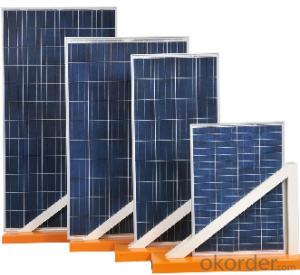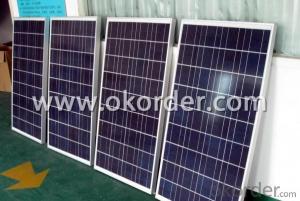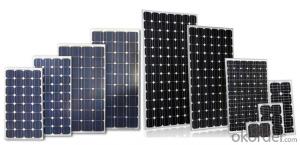Solar Panels on Townhouse - 295w CNBM Solar Polycrystalline Series III (280w—295w)
- Loading Port:
- China main port
- Payment Terms:
- TT OR LC
- Min Order Qty:
- 10000 watt
- Supply Capability:
- 500000 watt/month
OKorder Service Pledge
OKorder Financial Service
You Might Also Like
Specification
CNBM Solar Polycrystalline Series III (280W—295W)
Characteristics
Max Power Voltage Vmp(V) | 36.6 | 36.9 | 37.2 | 37.5 | ||
Max Power Current Imp(A) | 7.66 | 7.73 | 7.8 | 7.87 | ||
Open Circuit Voltage Voc(V) | 44.2 | 44.6 | 45.1 | 45.4 | ||
Short Circuit Current Isc(A) | 8.26 | 8.32 | 8.41 | 8 | ||
Max Power Pm(W) | 280 | 285 | 290 | 295 | ||
Temperature Coefficient of Cells
NOCT | 45℃±2℃ | |
Temperature Coefficients of Isc (%/℃) | - 0.0492 | |
Temperature Coefficients of Voc (%/℃) | – 0.3374 | |
Temperature Coefficients of Pmp (%/℃) | –0.4677 | |
Mechanical Data
Dimension | 1638 x 982 x 40 mm | |
Weight | 19.5kg | |
No. of Cells and Connections | 60 (6 x 10) | |
Tolerance | 0~+5W | |
Cell Monocrystalline Cell | 156 x 156 mm | |
Packing | 700 Pcs/40ft(H) Container |
Limits
Operating Temperature | –40 °C to +85°C | |
Storage Temperature | –40 °C to +85°C | |
Max System Voltage | 1000VDC(IEC) / 600VDC(UL) |
IV Curve



Image


Guarantees
Products Guarantee 12 yrs free from defects in materials and workmanship
Performance Guarantee No less than 90% within 10yrs and no less than 80% within 25yrs
Certificates TUV (IEC61215&IEC61730), VDE(IEC61215&IEC61730), UL, CE
FAQ
1. Q: Do you have your own factory?
A: Yes, we have. Our factory located in Jiangsu province.
2. Q: How can I visit your factory?
A: Before you take off from your country, please let us know. We will show you the way, or arrange time to pick you up if possible.
3. Q: Do you provide free sample?
A: Usually we do not offer free sample
4. Q: Could you print our company LOGO on the nameplate and package?
A: Yes, we can do that.
- Q: Science homework! I need to explain how a solar panel works and draw a Sankey Diagram for the solar panel, can anyone show me a sankey diagram for a solar panel or explain how a solar panel works?? ILL GIVE U BEST ANSWER IF U HELP WITH BOTH =]
- Not very helpful for my needs. I presume you work for one of the mega rich electrical companies. You must be a fun person to share adrink with. I ll provide the drink. At the witches bar. Hemlock i think. .................
- Q: Making a solar panelI know there was a recommended wattage for the soldering iron but i cant rememberdoes anyone know?
- Rosin okorder /
- Q: Is there any way to charge my laptop with a solar panel? Is there any panel like that. Or if I work on panels can I do something like that. If you know anything about it, can you just help me? Thanks a lot.
- A solar panel is usually 36 cells and intended to charge a 2V lead acid battery. The battery in laptops may be somewhere between 5 and 20V. The panel might charge a laptop when it is cold, but they heat up in the sun and then it would no longer charge. Typical lap top power supplies are 3 to 4 amps. You need 2 panels in series to get enough voltage to charge the battery directly, but this is wasteful. If you want to charge at the same rate as a lap top power supply you need large panels to provide 5 amps. The 5 Amp panel will only give 5A when pointed directly at the full sun. There may be between 2 and 5 hours a day equivalent full sun depending where you are, time of year. If you want more than that, you need larger panels, or more than one in parallel for a 2V system. It makes sense to charge a 2V battery with the solar panel, and use that to operate the lap top with a car type power supply for a laptop, which runs from a 2V battery (see link below for an example). Get the biggest panel you can afford, and the battery should be larger if you want to run the lap top when the sun isn't shining. Perhaps a 20AH battery is a minimum size. All this costs more than a lap top.
- Q: How do solar panels affect the resale value of a property?
- Solar panels can have a positive impact on the resale value of a property. Studies have shown that homes with solar panels tend to sell faster and at higher prices compared to homes without them. This is mainly because solar panels can lower energy costs for homeowners, increase energy efficiency, and contribute to a more sustainable lifestyle, all of which are highly valued by potential buyers.
- Q: Can solar panels be used for satellite communication?
- Yes, solar panels can be used for satellite communication. Solar panels are commonly used to provide power to satellites, including the communication systems on board. The panels convert sunlight into electricity, which is then used to operate the satellite's communication equipment and other systems.
- Q: I want to buy a solar panel from my house and I want to know how much it costs, what I have to buy and everything I need to know
- If okorder / for the solar panel design, Do it yourself DIY cheap and best guides which you can download right away. Using all the information, it will cost you less than $200 for building and complete installation of the solar panel in your house. This will cut your energy costs by atleast 50%. Many people are feeding the grid from the extra power they generate from renewable sources of energy like wind turbines and solar panels at home. So Good Luck!
- Q: Can solar panels be installed on a recreational vehicle (RV)?
- Yes, solar panels can be installed on a recreational vehicle (RV). Many RV owners choose to install solar panels on their vehicles to generate electricity and reduce their reliance on traditional power sources while on the road. Solar panels can provide a sustainable and eco-friendly solution for powering various appliances and systems in an RV, making it more self-sufficient and energy-efficient.
- Q: How do solar panels affect the value of a home?
- Solar panels can significantly increase the value of a home. They offer long-term cost savings on electricity bills and can generate additional income through net metering or selling excess energy back to the grid. Additionally, solar panels are environmentally friendly, which appeals to many buyers and can make a property more attractive in the market.
- Q: Do solar panels require a specific type of mounting system for installation?
- Yes, solar panels typically require a specific type of mounting system for installation. The mounting system is designed to securely hold the solar panels in place and ensure optimal positioning for maximum sunlight exposure. There are various types of mounting systems available, including roof mounts, ground mounts, and pole mounts, each suited for different installation scenarios.
- Q: That one costs money but looks like it might work. I don't really have the money for it but if it works then it would probably be worth it. Do homemade solar panels really work or is it just a gimmick? I'm really interested to see if anyone has actually tried this and to see what they say about it.Thanks
- Home made solar panels should work just as well. You can make some thrifty ones that don't cost thousands of dollars! And it will truly save you a lot of money in the long run and can even power your home, even after a storm when everyone elses power is out
Send your message to us
Solar Panels on Townhouse - 295w CNBM Solar Polycrystalline Series III (280w—295w)
- Loading Port:
- China main port
- Payment Terms:
- TT OR LC
- Min Order Qty:
- 10000 watt
- Supply Capability:
- 500000 watt/month
OKorder Service Pledge
OKorder Financial Service
Similar products
Hot products
Hot Searches
Related keywords


























